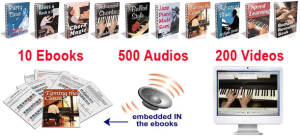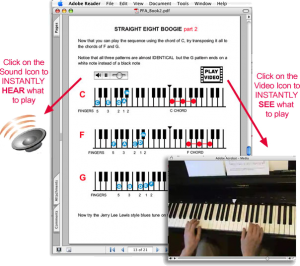PianoForAll Review
Is PianoForAll Worth $39?
Hello everyone. I hope that you have been enjoying the free video piano lessons that I’ve been providing for you. This week I have decided to give my first product review. Don’t worry – I will continue providing you with free lessons starting again next week. This post is for those of you that may be considering purchasing a program to help you learn how to become a more advanced piano player in as little time as possible. Today I have decided to review a program called Pianoforall.
Pianoforall consists of ten eBooks. Embedded in these ebooks are about 200 video piano lessons and 500 audio piano lessons. As of now I have read through all of the material, played many of the audio and video files, and spent several weeks going through many of the lessons at my piano. I must say that I am quite impressed. The information is presented in a way that will have most readers playing the piano almost immediately. Although the lessons focus on getting the reader to learn to play by ear, there is plenty of musical theory there as well. It is just covered very slowly, so it never comes across as overwhelming or uninteresting.
Audio and Video
 The audio and video function exceptionally well (at least on my computer). Whenever the reader is having trouble determining if they are playing something correctly, they can simply click on the audio button next to that piece of music, and a little player will open up that plays the whole passage.
The audio and video function exceptionally well (at least on my computer). Whenever the reader is having trouble determining if they are playing something correctly, they can simply click on the audio button next to that piece of music, and a little player will open up that plays the whole passage. I do have two small gripes with the audio: First, the player that opens up sometimes covers a written chord on the page that I may have wanted to see as I was listening to the audio. I then had to wait for the audio to finish before the player closed and I could see that chord again. This is a minor nuisance, but I think it can be easily repaired by adjusting the location of some of these audio buttons, or some small changes in the formatting of the text. Second, I wish that pressing play on one audio player would automatically shut off the one that was already playing. Instead, both audio tracks will play simultaneously. I hope that the author takes these two issues into consideration for future updates.
Update (4/26/2014): The author has now corrected the two audio issues I had. I love the changes he made.
The videos have been shot well. In some video programs that I have seen, the piano is shot at an angle that makes it difficult for the viewer to see how the part is being played. This is not the case here – the camera angle and lighting allow you to see exactly where the fingers are and what is being played very clearly. And the author clearly knew exactly which videos were needed. Any time there is something in writing that could be confusing to some readers, there is a video there to clarify it. But what I find even nicer is that I’m not forced to watch all the videos. The video buttons are subtly placed at the top of many pages. You can simply ignore them until you get to a part that confuses you. When you need it, simply click on the video button on the top of that page, and the video pops up in the middle of the screen. As soon as you’ve seen enough of the video to clarify what you were confused about, you can close it, and continue reading. I should point out that the overall quality of the videos is not that good. If you are the type of person that wants really sharp, high definition videos, then this may bother you. I however am not bothered at all by this. Everything that needs to be seen in the videos is very clear as I’ve emphasized in the beginning of this paragraph.
Update (4/26/2014): The author has updated all of the videos – very nicely done!
Quality of Written Material
 The material itself is presented in a way that I have never seen before, and I must say it is quite refreshing. The lessons get right to the point. There is no fluff – everything that is taught is designed to get you playing songs on the piano as quickly as possible. As an educator myself, I really appreciate the teaching methods used here. Since there is so much material to talk about, I thought it best to go through each book one at a time. For those you who would rather just go take a look at the product on the author’s website, here is the link:
The material itself is presented in a way that I have never seen before, and I must say it is quite refreshing. The lessons get right to the point. There is no fluff – everything that is taught is designed to get you playing songs on the piano as quickly as possible. As an educator myself, I really appreciate the teaching methods used here. Since there is so much material to talk about, I thought it best to go through each book one at a time. For those you who would rather just go take a look at the product on the author’s website, here is the link:
Book 1
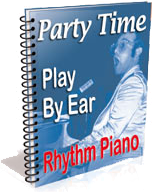 This first 93 page book is titled “Party time,” and its main goal is to teach 10 basic rhythms that will allow the reader to be able to play an enormous number of well-known songs by the time they are finished with the book. When I first started learning the piano, my piano teacher had me focusing on tedious drills and exercises long before I started learning any songs. I like the approach used in this book much better.
This first 93 page book is titled “Party time,” and its main goal is to teach 10 basic rhythms that will allow the reader to be able to play an enormous number of well-known songs by the time they are finished with the book. When I first started learning the piano, my piano teacher had me focusing on tedious drills and exercises long before I started learning any songs. I like the approach used in this book much better.
The first rhythm (left note/right chord) is very easy and is a nice starting point for anyone that has little to no piano playing experience. The rhythms then slowly increase in difficulty as you learn the straight beat, the oom pah, the split chord, the half beat bounce, two versions of the twist, the 3 beat bounce, the 12/8 country shuffle, and the bossa nova bounce. If you don’t recognize the names of these rhythms, that is okay – neither did I. But as soon as you start playing them, your head will be flooded with familiar songs that make use of these rhythms.
Real songs are used as exercises to illustrate each rhythm as you go through the book. Here are some examples of songs you begin learning to play and the rhythm that they are used to demonstrate:
“Hit the Road Jack” – left note/right chord
“Bye Bye Love” – oom pah
“Imagine” – split chord
“Sweet Home Alabama” – half beat bounce
“Piano Man” – 3 beat bounce
“In The Air Tonight” – bossa nova bounce
I believe that hearing yourself playing songs you know coming from your piano almost from the jump must be satisfying. This should give most people the motivation to continue on to the more advanced material presented in the next books.
Although only a small amount of musical notation is introduced at a time, by the end of this book you should have enough of an understanding of how sheet music works to be able to read and play simple pieces of music.
Musical theory is introduced slowly as it is needed to play various songs and demonstrate the rhythms being taught. For example, in order to demonstrate the first rhythm only four chords in the key of C are introduced. This is followed by the other three basic chords in the key of C. After the third rhythm is learned, 4 more basic chords are introduced to get the reader ready to begin working in keys other than the key of C. Finally, a few of the simpler 7th chords and slash chords are introduced. These last two chord types are not too difficult to learn, but they produce really nice sounds, and allow the reader to play a much wider variety of songs.
Book 2
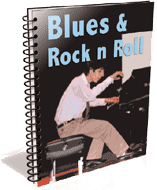 The second book titled “Blues and Rock and Roll” is only 21 pages. This book focuses on 5 new rhythms that all blues musicians are very familiar with. The first rhythm (basic triad blues) is very simple (and quite frankly not very interesting), but it’s a nice warm up for the other four which I like much better. The rhythms increase in difficulty from easiest to hardest as you learn the straight eight boogie, the blueberry hill, the 12/8 boogie shuffle, and the blues brothers.
The second book titled “Blues and Rock and Roll” is only 21 pages. This book focuses on 5 new rhythms that all blues musicians are very familiar with. The first rhythm (basic triad blues) is very simple (and quite frankly not very interesting), but it’s a nice warm up for the other four which I like much better. The rhythms increase in difficulty from easiest to hardest as you learn the straight eight boogie, the blueberry hill, the 12/8 boogie shuffle, and the blues brothers.
I do think that there was a bit of a missed opportunity with this book. No new keys or chords are introduced, and the primary focus is on the key of C (with only a few examples using any chords with black notes). I think that it would have been nice if the author added another 5 to 10 pages with material introducing just a few new chords, as well as some examples that use these chords in the rhythms that were taught in this book. In my opinion, this would have made the transition to the next book (which is heavier on theory) a bit smoother. This is just a minor complaint though. The series as a whole covers a huge amount of material, and does so in a very natural way that is quite easy to follow.
Book 3
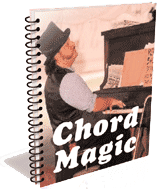 The third book is titled “Chord Magic” and it consists of 32 pages. As the title suggests, this is the book that teaches you all 24 basic major and minor chords. Although this book is not very long, there is a lot to learn from it. I recommend really taking your time with this book. The average student will probably need several weeks to internalize all of the information presented here.
The third book is titled “Chord Magic” and it consists of 32 pages. As the title suggests, this is the book that teaches you all 24 basic major and minor chords. Although this book is not very long, there is a lot to learn from it. I recommend really taking your time with this book. The average student will probably need several weeks to internalize all of the information presented here.
I think that this book is the appropriate time to finally reveal all the basic chords that an aspiring musician needs to know. The material presented here is pretty standard, but the timing of this presentation is what makes this product stand out from others. I think if this material was presented in the first book, a lot of people would get turned off very quickly. Waiting until book 3 to reveal this information was a fantastic idea. Anyone who makes it this far is already able to play 15 rhythms, and hundreds of songs. This should be enough to give the motivation to expend the time and energy necessary to master all the major and minor chords.
In addition to learning the 24 major and minor chords in root position, the other two inversions are taught as well. The book finishes with some nice exercises using the cycle of fifths that will help the reader to internalize all of these chords as well as their inversions.
Book 4
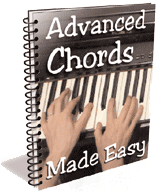 The fourth book titled “Advanced Chords” consists of 26 pages. The mere mention of the material covered in this book is enough to scare anyone away, but everything is handled very well here – especially for beginners! 9th chords, 11th chords, and suspended 4th chords all sound very scary, but the author provides a nice simple trick to “bluff your way” through these chords. Diminished chords and cluster chords are also taught very well here. As usual, these chords are all demonstrated within the context of real songs.
The fourth book titled “Advanced Chords” consists of 26 pages. The mere mention of the material covered in this book is enough to scare anyone away, but everything is handled very well here – especially for beginners! 9th chords, 11th chords, and suspended 4th chords all sound very scary, but the author provides a nice simple trick to “bluff your way” through these chords. Diminished chords and cluster chords are also taught very well here. As usual, these chords are all demonstrated within the context of real songs.
There is a whole section dedicated to replicating the sound of Barry Mannilow, and another section for the Beatles. So your overall enjoyment of this book may depend a bit on how much you appreciate these two artists. But do not worry too much if you’re not a Barry Mannilow or Beatles fan – there are lots of other song examples as well.
Overall this book does a really nice job of simplifying some really advanced material. It can be easy to get overwhelmed by the difficulty level of learning these new chords, but it is all done here in one of the simplest ways I have ever seen.
Book 5
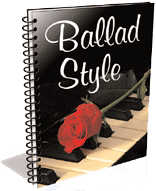 Book 5 is a 66 page book titled “Ballad Style.” I really like this book. A lot of great material is in here to take the reader to the next level. The book first teaches a very basic ballad style left hand rhythm. Anyone that has made it this far will have no trouble at all with this rhythm. Nonetheless, it is a rhythm that I particularly like. The pentatonic scale is then introduced. This scale is like a gift for newbies. You can play the notes of this scale any way you want, without any rules, and it always sounds good. This seems like the perfect time to introduce improvisation, and that’s exactly what is done. Playing the simple ballad style rhythm with the left hand, and improvising over the pentatonic scale with the right hand makes for some really fun and nice sounding music.
Book 5 is a 66 page book titled “Ballad Style.” I really like this book. A lot of great material is in here to take the reader to the next level. The book first teaches a very basic ballad style left hand rhythm. Anyone that has made it this far will have no trouble at all with this rhythm. Nonetheless, it is a rhythm that I particularly like. The pentatonic scale is then introduced. This scale is like a gift for newbies. You can play the notes of this scale any way you want, without any rules, and it always sounds good. This seems like the perfect time to introduce improvisation, and that’s exactly what is done. Playing the simple ballad style rhythm with the left hand, and improvising over the pentatonic scale with the right hand makes for some really fun and nice sounding music.
The improvisation taught here is also the first time that melody lines are introduced. Improvisation over a simple scale that always sounds good is a really nice way to do this. The book then switches gears and focuses on playing melodies in a more structured setting. So in this one book the reader is taught to play melodies in both a structured and unstructured way, and it never comes across as “too much, too soon.” There are plenty of song transcriptions here with full melody lines (together with the ballad rhythm on the bass staff) to practice with.
This book finishes with some beautiful (and slightly more difficult) variations of the ballad rhythm – I really love these rhythms, and I realize that I actually use these often in my own songwriting and improvisations. Once again there are lots of examples to practice with
Book 6
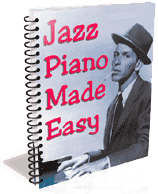 Book 6 is titled “Jazz Piano Made Easy,” and it contains 86 pages. I have never been too interested in Jazz music, and I have little to no experience playing it. I do not love Jazz or hate it – I’m pretty indifferent towards it. But I certainly do appreciate the talent it takes to perform it well. When it comes to Jazz I consider myself a beginner. So I believe that going through this book allowed me to experience the product as it was intended. No – the book didn’t make me fall in love with Jazz music. But it did make me realize for the first time that learning to play Jazz music does not have to be as difficult as I once thought.
Book 6 is titled “Jazz Piano Made Easy,” and it contains 86 pages. I have never been too interested in Jazz music, and I have little to no experience playing it. I do not love Jazz or hate it – I’m pretty indifferent towards it. But I certainly do appreciate the talent it takes to perform it well. When it comes to Jazz I consider myself a beginner. So I believe that going through this book allowed me to experience the product as it was intended. No – the book didn’t make me fall in love with Jazz music. But it did make me realize for the first time that learning to play Jazz music does not have to be as difficult as I once thought.
The book begins with Blues (which I consider “Jazz lite”). This is a great way to start. Blues is much easier than Jazz, but it has many of the same elements. Therefore it serves as a nice bridge to get from easier to more difficult material.
After focusing on three 7th chords in the left hand that are very simple to play, the book introduces the minor pentatonic scale (or “blues scale”). This is another magic scale that is easy to learn. It allows anyone with just a bit of piano playing experience to sound like they’ve been playing the blues their whole life. Some standard blues riffs are shown as well – as you play them you will be reminded of many familiar songs.
Jazz is then introduced in just the key of C with a few 7th chords, at first just in root position (to keep it simple), and then later in their more natural inversions. Improvisation over some basic chords is emphasized almost right away, and I found it very easy to follow.
My girlfriend was sitting on the couch as I was going through some exercises toward the beginning of the book, and she commented “I never heard you play music like that before – it sounds amazing.” She didn’t realize I was just doing the exercises from a book I was planning to review on this website. When I said “it can’t sound that good yet – I just started learning this 20 minutes ago,” she replied with “it feels like I’m sitting in a lounge listening to a professional Jazz musician at the piano.”
Anyway, the book proceeds with some more advanced (but surprisingly easy to learn) techniques like the caterpillar walk, chordal improvisation, two handed comping, and quartal harmony. These are all terms I had never heard before, but I was able to understand and apply everything quite easily.
It may just be my inexperience with Jazz music, but I felt that this book contained by far the most information out of all the books up until this point.
Book 7
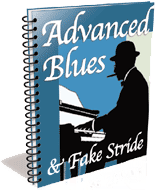 Book 7 titled “Advanced Blues” contains 60 pages. This book begins by teaching the reader a bit about transposing a composition. I’m not certain that this was the right place for this information, but I’m also not really sure where it belongs. In any case it’s perfectly fine that this information is taught here – I just don’t see how it is more relevant to this book than any of the others. That said, I think that the “Instant Transposer” is a nice chart that can be useful for aspiring piano players.
Book 7 titled “Advanced Blues” contains 60 pages. This book begins by teaching the reader a bit about transposing a composition. I’m not certain that this was the right place for this information, but I’m also not really sure where it belongs. In any case it’s perfectly fine that this information is taught here – I just don’t see how it is more relevant to this book than any of the others. That said, I think that the “Instant Transposer” is a nice chart that can be useful for aspiring piano players.
There is then a brief review of the left hand rhythms from Book 2 (anyone that has gotten this far should find these very easy at this point), and some nice right hand riffs are then added over these rhythms. Quite a bit of time is spent on the sheet music for these really nice sounding riffs, so the reader can get plenty of practice. I especially like the slides which give a nice blues sound that is sure to impress anyone listening. The tremolos are very nice too – they’re easy to play, but make you sound like a real professional.
Some time is then spent on reviewing all of this material in the key of G (only the key of C has been emphasized to this point). This is really nice – I only wish that the book series up to this point as a whole spent more time exploring other keys, just as was done in this section. For the most part, the books focus on the key of C, but leave it to the reader to transpose everything to other keys. I think that readers would actually appreciate a little more hand holding in this regard. (Note that book 9 does actually do a very good job of this.)
The last section focuses on “The Fake Stride.” I absolutely love, love, love this material. Playing a real stride is extremely difficult. Teaching this faux version is brilliant! I remember struggling for days on end when I was younger trying to get through Scott Joplin’s brilliant piece “The Entertainer.” If I had been taught the fake stride, I would have been able to get through the song much more easily. The fake stride allows you to focus on practicing the melody, while still being able to play a left hand that sounds very close to the real thing. Many people may not even be able to tell the difference between this much easier version and the real stride. For those who want to learn the more difficult version, using the fake stride is a really nice stepping stone on your way to learning the genuine piece. The sheet music for two (simpler) versions of the first movement of “The Entertainer” are provided here so that the reader can begin to learn this wonderful song.
Book 8
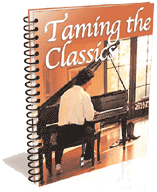 Book 8 is titled “Taming the Classics” and it consists of 71 pages. This book begins by reviewing and expanding upon the theory that was taught in the first book. It is hard to believe that this is the first time a key signature is mentioned, but to me it actually feels like the right place to introduce this concept. A bare minimum of theory is taught here – I actually think a bit more could have been done.
Book 8 is titled “Taming the Classics” and it consists of 71 pages. This book begins by reviewing and expanding upon the theory that was taught in the first book. It is hard to believe that this is the first time a key signature is mentioned, but to me it actually feels like the right place to introduce this concept. A bare minimum of theory is taught here – I actually think a bit more could have been done.
After the small amount of theory is covered, the rest of the book focuses on getting the reader to practice reading and performing classical pieces of music. Helpful tips are provided along the way as the author presents one piece after another in increasing order of difficulty.
The sheet music that is presented has some really nice characteristics. To make the sheet music much easier to read, most of the note names are given right above each note, and all notes which are sharp or flat are displayed in red. This is great for the reader whose piano playing skills are improving faster than their sight reading skills.
The pieces that you will learn to play here include Fur Elise (1st movement) , Air On A G String, the Blue Danube, and Moonlight Sonata (1st movement). These are just a few of the pieces you will be practicing – there are many more.
Overall I do really like this book. My only minor complaint is that I think there were some missed opportunities here to sprinkle in a bit more theory. It would have been relatively easy to discuss a new piece of piano notation (or even review one that was already presented) before or after each song.
Book 9
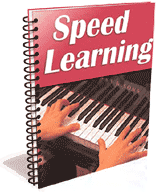 The ninth book is titled “Speed Learning,” and it consists of 120 pages. If you have made it through the first 8 books, then you can already play the piano. You should be able to play lots of nice sounding rhythms with your left hand, improvise melodies over certain chord progressions, and pick up a piece of sheet music and, with a bit of practice, play that particular song pretty well.
The ninth book is titled “Speed Learning,” and it consists of 120 pages. If you have made it through the first 8 books, then you can already play the piano. You should be able to play lots of nice sounding rhythms with your left hand, improvise melodies over certain chord progressions, and pick up a piece of sheet music and, with a bit of practice, play that particular song pretty well.
The fun is finally over.
For those readers that want to progress to the next level, here is where it will happen. This book begins by helping the reader learn how to play and memorize all the important scales and arpeggios. This is followed by a chord and scale workout in the key of C. The book handles these exercises very well. But let’s face it – they are still exercises. This certainly isn’t the most interesting part of learning how to play the piano. But it is necessary if you want to get to the next skill level.
I am happy to see that after going through the exercises in C, the book goes through every other key in the same detail (which is why this book is so long). I think this is important because if it wasn’t all there in writing I think that many readers simply would not do it. The author recommends spending a week perfecting each key, and I second that recommendation. If you have made it this far and you want to get really good, then practice makes perfect.
Book 10
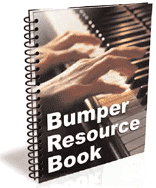 The tenth and final book is titled “Bumper Resource Book,” and it consists of 33 pages. The book consists of a list of resources that the author claims to update on a regular basis. Everything in here seems to be current to me.
The tenth and final book is titled “Bumper Resource Book,” and it consists of 33 pages. The book consists of a list of resources that the author claims to update on a regular basis. Everything in here seems to be current to me.
The information in this book includes advice on choosing a piano/keyboard, MIDI information, a list of useful websites, a song list organized by rhythm, and piano book reviews.
I’m not sure that this should have been considered a book in the series since it does not actually teach any piano itself, but I would not go so far as to say that it is deceptive to include it as the tenth book. It does contain resources that readers will find useful if they wish to continue playing the piano.
For more information or to purchase this product, click on the following link: Pianoforall
Final Analysis
Pianoforall is a well written beginner piano course that emphasizes rhythm and application over theory. If you want to start playing the piano right away without worrying too much about general theory, then this course is probably good for you. If you would prefer to learn piano the traditional way (lots of theory, finger exercises, etc.), then this is not the right course for you. The audio and video are very helpful in expediting the learning process.
Final Score: 9/10
Full Disclaimer: I have received no compensation from Pianoforall for this review. Pianoforall did provide me with all materials at no charge, but I have no personal interest in this product.
I spent several weeks reviewing this program thoroughly, and the opinions that I have shared about this program are all my own. I take great pride in providing accurate, useful, and honest information to my audience.
The links in this blog are affiliate links. If you click on one of these links and decide to purchase a product from Pianoforall I will receive a commission on the sale. This does not cost you anything additional. These commissions help to keep the rest of my content free, so thank you!

